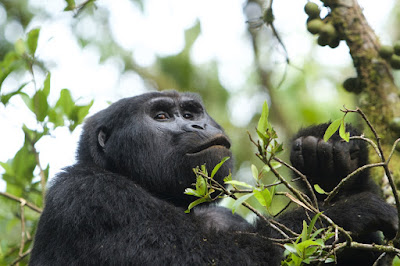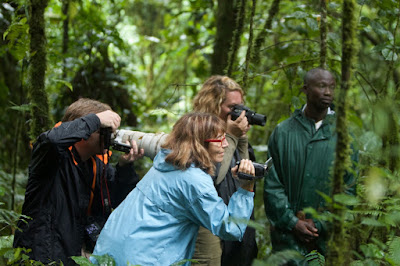I would like to share with you my experience and that of my guests, tracking the gorillas at Bwindi Impenetrable forest in Uganda. The experience is amazing and one of the things one should do in their lifetime. We had 2 great days of trekking recently and below are some of the photos of the trip
Bwindi
Impenetrable National Park
Bwindi
Impenetrable National Park lies in southwestern Uganda on the edge of the Rift
Valley. Its mist-covered hillsides are blanketed by one of Uganda's oldest and
most biologically diverse rainforests, which dates back over 25,000 years and
contains almost 400 species of plants. More famously, this “impenetrable
forest” also protects an estimated 320 mountain
gorillas – roughly half of the world’s population, including several habituated
groups, which can be tracked.
This
biologically diverse region also provides shelter to a further 120 mammals,
including several primate species such as baboons and chimpanzees, as well as
elephants and antelopes. There are around 350 species of birds hosted
in this forest, including 23 Albertine Rift endemics.
The
neighboring towns of Buhoma and Nkuringo both have an impressive array of luxury lodges,
rustic bandas and budget campsites, as well as restaurants, craft
stalls and guiding services. Opportunities abound to discover the local Bakiga and Batwa
Pygmy cultures through performances, workshops and village walks.
History
In 1932,
two blocks of the Bwindi Impenetrable Forest
were designated as Crown Forest Reserves. The northern block was designated as
the "Kayonza Crown Forest Reserve", and the southern block designated
as the "Kasatora Crown Forest Reserve". These reserves had a combined
area of 207 square kilometers. In 1942, the two Crown Forest Reserves were
combined and enlarged, and renamed the Impenetrable Central Crown Forest. This
new protected area covered an area of 298 square kilometers and was under the
joint control of the Ugandan government's game and forest departments.
In 1964,
the reserve was designated as an animal sanctuary in order to provide extra
protection to its mountain gorillas and renamed the Impenetrable Central Forest
Reserve. In 1966, two other forest reserves became part of the main reserve,
increasing its area to almost 321 square kilometers. The park continued to be
managed as both a game sanctuary and forest reserve.
In 1991,
Impenetrable Central Forest Reserve along with Mgahinga Gorilla Reserve and
Rwenzori Mountains Reserve was designated as a national park and renamed Bwindi Impenetrable
National Park. It covered an area of 330.8 square kilometers.
The national park was declared in part to protect a range of species within it,
most notably the mountain gorilla. The reclassification of the park had a large
impact on the Batwa pygmy people, who were evicted from the forest and no
longer permitted to enter the park or access its resources. Gorilla tracking
became a tourist activity in April 1993, and the park became a popular tourist
destination. In 1994, it was inscribed on the World Heritage List and a 10
square kilometer area was incorporated into the park. The park's management
changed: Uganda National Parks, since renamed Uganda Wildlife Authority, became
responsible for the park. In 2003 a piece of land next to the park with an area
of 4.2 square kilometers was purchased and incorporated into the park.
The park
is inhabited by a population of about 340 individuals of Mountain Gorillas
(Gorilla beringei beringei), commonly referred to as the Bwindi population,
which makes up almost half of all the mountain gorillas remaining in the world.
The rest of the worldwide mountain gorilla population is in the nearby Virunga
Mountains which is shared by Rwanda, Uganda and Democratic Republic of Congo.
The major threat to these mountain gorillas is poaching, habitat loss and
disease, however, since 1997; there has been a gradual increase in the mountain
gorilla population in Bwindi from 300 individuals to about 340 individuals in
2006.
Recent
research has shown that the Bwindi gorilla's diet is patently higher in fruit
than that of the Virunga population, and that the Bwindi gorillas, even
silverbacks, are more likely to climb trees to feed on foliage, fruits, and
epiphytes. In some months, Bwindi gorilla diet is very similar to that of
Bwindi chimpanzees. It was also found that Bwindi gorillas travel further per
day, particularly on days when feeding primarily on fruit than when they are
feeding on fibrous foods. Additionally, Bwindi gorillas are much more likely to
build their nests in trees, nearly always in, a small understory tree.
There are
no mountain gorillas recorded in captivity explaining why they are indeed an
endangered species with an estimated total population of about 650 individuals.
Le Hoest monkey; one of the many primates found in Bwindi
One of our first Gorilla on our day 1
A brief view of Bwindi
In the forest; walking back. There is a defined trail
A young Gorilla crossing a little stream in the forest
Relaxing at Mid-morning
Great photo opportunity
Some of our armed guards, walking ahead of us in the forest.
A better view of Bwindi from a high ground
At our briefing point before the trek
The porters not only helps you carry your bags, but supports you through difficult sections
Other interesting creatures in the forest




































3 comments:
Adorable Post.
Thanks for sharing about fantastic place.
Gorilla Trekking Uganda
Nice Blog.
Thank you for sharing this very nice post, please keep continue the sharing of this types of information.
bwindi Gorilla Tracking Uganda
Good post.
I think best information here. I like it very much
We all are appreciating your website.
bwindi Gorilla Tracking Uganda
Post a Comment